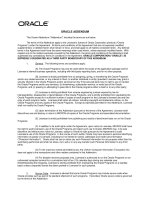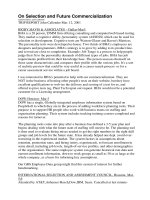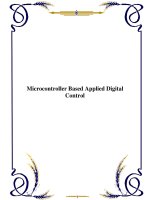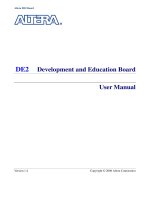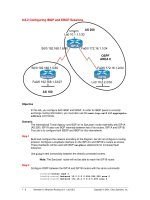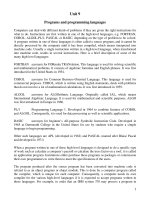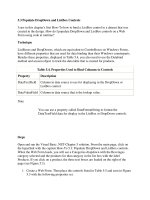Tài liệu Intellectual Property and Information Control pdf
Bạn đang xem bản rút gọn của tài liệu. Xem và tải ngay bản đầy đủ của tài liệu tại đây (1000.29 KB, 267 trang )
Intellectual Property and
Information Control
This page intentionally left blank
Intellectual Property and
Information Control
Philosophic Foundations and
Contemporary Issues
Adam D. Moore
Transaction Publishers
New Brunswick (U.S.A.) and London (U.K.)
Copyright © 2001 by Transaction Publishers, New Brunswick, New Jersey
08903.
All rights reserved under International and Pan-American Copyright Conventions. No part of this book may be reproduced or transmitted in any form or by
any means, electronic or mechanical, including photocopy, recording, or any
information storage and retrieval system, without prior permission in writing
from the publisher. All inquiries should be addressed to Transaction Publishers,
Rutgers—The State University, New Brunswick, New Jersey 08903.
This book is printed on acid-free paper that meets the American National Standard for Permanence of Paper for Printed Library Materials.
Library of Congress Number: 2001027885
ISBN: 0-7658-0070-5
Printed in the United States of America
Library of Congress Cataloging-in-Publication Data
Moore, Adam D.
Intellectual property and information control : philosophic foundations and
contemporary issues / Adam D. Moore.
p. cm.
Includes bibliographical references and index.
ISBN 0-7658-0070-5 (alk. paper)
1. Intellectual property—United States. 2. Computer systems—Law
and legislation—United States. 3. Data transmission systems—Law
and legislation—United States I. Title.
KF2979 .M66 2001
346.7304'8—dc21
2001027885
Dedicated to Kimberly, Alan, and Nancy
This page intentionally left blank
Contents
List of Tables
ix
Preface
xi
Acknowledgments
xiii
1.
Introduction and Overview
1
2.
The Domain of Intellectual Property
9
3.
Against Rule-Utilitarian Intellectual Property
37
4.
A Pareto-Based Proviso on Original Acquisition
71
5.
Toward a Lockean Theory of Intellectual Property
103
6.
Justifying Acts, Systems, and Institutions
121
7.
A New Look at Copyrights, Patents, and
Trade Secrets
147
8.
Intangible Property: Privacy, Power, and
Information Control
181
9.
Employee Monitoring, Nondisclosure
Agreements, and Intangible Property
195
10. Owning Genetic Information and Gene
Enhancement Techniques
211
11. Information Control and Public Policy:
The Encryption Debate
223
Bibliography
237
Index
249
List of Tables
Table
1.1
Worldwide Software Piracy Table
2.1
Systems of Property
2.2
Simplified Relationships Between Patents, Copyrights,
Trademarks, and Trade Secrets
4.1
The Baseline Table
4.2
Opportunities Table
5.1
Rivalry of Goods
6.1
Pareto Superiority and Private Property Relations
6.2
Levels of Justification
This page intentionally left blank
Preface
This work contains numerous arguments, sketches, views, and
theories and not all are central to the main thesis. I have tried to
make the model of intellectual and intangible property presented in
these pages accessible while maintaining a fair amount of rigor and
depth. I thus skirt the line of boring the expert and overwhelming
the novice. My hope is that I have done neither.
After gaining the overview offered in chapter 1, the reader who
wishes to move rapidly may want to skim or omit certain sections or
chapters. Chapters 3-6 are the argumentative core of the book while
chapters 7-11 contain applications of the theory. Sections of chapters are appropriately titled so that the reader can quickly surmise if
skimming or omission would be appropriate. For example, experts
in moral theory may want to skip the second section of chapter 3
entitled A General Overview of Utilitarian Theory while those well
versed in intellectual property law (copyrights and patents) may want
to omit the first few sections of chapter 2.
The claim that “there is room for words on subjects other than last
words” is certainly true of this work. I do not pretend to offer a
complete theory that is unassailable and neatly packaged — the moral,
legal, and political issues discussed herein are resistant to easy answers. What you will find is an intuitive model of intangible property that is both clearly presented and well reasoned. The tensions
between intellectual property, information access, privacy, free
speech, and accountability have been highlighted with the coming
of the networked world. My hope is that this work will add to what
has become a lively area of philosophical debate.
A.D.M.
xi
This page intentionally left blank
Acknowledgments
I would like to thank Don Hubin (Ohio State University) and Peter King (Ohio State University) for reading and commenting on the
first draft of the manuscript. Their comments and criticisms have
profoundly influenced this work. Thanks to David T. Wasserman
(University of Maryland, College Park), Ken Itkowitz (Marietta College), Jim Swindler (Wittenberg University), Earl Spurgin (John Carol
University), Avery Kolers (University of Arizona), Richard Garner
(Ohio State University), Nancy Snow (Marquette University), Dan
Farrell (Ohio State University), and John Moser (Institute for Humane Studies) for commenting on specific chapters or sections.
Chapters 3, 4, 5, 8, 9, and 10 benefited significantly from being
presented at various conferences and colloquia series including:
Pacific Division Meeting of the American Philosophical Association
(April 2000); 27th Conference on Value Inquiry (April 1999); MidSouth Philosophy Conference (March 1999); Ohio Philosophical
Association Conference (April 1998); Central Division Meeting of
the American Philosophical Association (1997); and the Mountain
Plains Philosophy Conference (1997). My gratitude to those conference participants who provided helpful comments and suggestions.
Parts of chapters 1, 4, and 6 appear in “Introduction to Intellectual Property” and “Toward a Lockean Theory of Intellectual Property” in my edited anthology, Intellectual Property: Moral, Legal,
and International Dilemmas (Rowman and Littlefield, 1997). Earlier versions of sections of chapters 4 and 7 appear in “A Lockean
Theory of Intellectual Property” found in the Hamline Law Review
21 (Fall 1997). Chapter 8 draws directly from material that originally appeared in “Intangible Property: Privacy, Power, and Information Control,” American Philosophical Quarterly 35 (October
1998). Material from an earlier version of chapter 9 was published
in Business Ethics Quarterly 10 (July 2000) entitled “Employee
Monitoring and Computer Technology: Evaluative Surveillance v.
xiii
xiv
Intellectual Property and Information Control
Privacy.” Chapter 10 contains material published in Bioethics 14
(Spring 2000) entitled “Owning Genetic Information and Gene Enhancement Techniques.” Chapter 11 draws from an article, “Privacy
and the Encryption Debate,” in Knowledge, Technology, and Policy
12 (Winter 2000). I thank editors of these publishers for allowing
me to present this material here.
A special thanks to my friends and loved ones who have supported me throughout the writing process—Scott Rothwell, Mark
VanHook, Walter James, Bill Kline, Nick Morse, James Summerford,
Nancy Moore, Alan Moore, and Kimberly Moore.
I also would like to thank Nancy Moore for reading, editing, and
commenting on an early draft and the Institute for Humane Studies
(George Mason University, Fairfax, VA) for a summer fellowship
(1997) that provided much needed support during the initial writing
stages.
1
Introduction and Overview
“I would like to leave you with the impression that if you make a single illegal
copy of our software, you will spend the next five years in court, the following ten
in prison, and forever after your soul will suffer eternal damnation.”
—V. Rosenburgh, “Copyright and the New Technology”1
Introduction
Access to ideas, and to the physical embodiments of ideas, fundamentally shapes our opportunities, goals, and lifelong projects.
The explosion of computer technology and the proliferation of digital networks has radically altered the way that ideas and information
are gathered and manipulated. New models of information access
and control promise profound changes for each of us—as life-altering as the changes that flowed from the introduction of Gutenberg’s
press, Darwin’s theory of evolution, or Pasteur’s germ theory of disease.
In modern times the debate over the control and ownership of
digital information and intellectual property has been waged by two
factions. Standing in the way of the cyber-punks, hackers, and net
surfers who claim that “information wants to be free” and that intellectual property rights give undue credit to authors and inventors,
are the collected cannons of Anglo-American copyright, patent, and
trade secret law. Defenders of these institutions typically argue that
granting rights to authors and inventors is necessary for the optimal
production of intellectual works and the corresponding gains in social utility. Information, like any other commodity, can be bought
and sold on the open market. Following Nathaniel Shaler many defenders of intellectual property argue that “there is no property more
peculiarly a Man’s own than that which is produced by the Labour
of his mind”2 or “[I]t will be clearly seen that intellectual property
1
2
Intellectual Property and Information Control
is, after all, the only absolute possession in the world. . . The man
who brings out of nothingness some child of his thought has rights
therein which cannot belong to any other sort of property.”3
Conversely, opponents argue that intellectual property rights give
undue credit to authors and inventors and serve to restrict the free
flow of information that would otherwise benefit everyone. Another
reason why many individuals find it difficult to recognize intellectual property rights is that they see ideas as part of one’s common
culture. Ideas are not to be corralled or hoarded up—they are the
common currency of thought, speech, and language. 4 Thomas
Jefferson wrote:
If nature has made any one thing less susceptible than all others of exclusive property,
it is the action of the thinking power called an idea, which an individual may exclusively
possess as long as he keeps it to himself; but the moment it is divulged, it forces itself
into the possession of everyone, and the receiver cannot dispossess himself of it. Its
peculiar character, too, is that no one possesses the less, because every other possesses
the whole of it. He who receives an idea from me, receives instruction himself without
lessening mine; as he who lights his taper at mine, receives light without darkening me.
That ideas should freely spread from one to another over the globe, for the moral and
mutual instruction of man, and improvement of his condition, seems to have been
peculiarly and benevolently designed by nature, when she made them, like fire, expansible over all space, without lessening their density at any point, and like the air in which
we breathe, move, and have our physical being, incapable of confinement or exclusive
appropriation. Inventions then cannot, in nature, be a subject of property.5
Jefferson was impressed with the non-rivalrous nature of intellectual property—intellectual works can be used and consumed by many
individuals concurrently. He was certainly opposed to granting intellectual property rights to ideas already in the public domain. While
Jefferson’s metaphor of passing light or fire along to others is a strong
one, I wonder if he would defend this view if the creator of the light
had labored ten years to produce it. In subsequent chapters I will
argue that the non-rivalrous nature of intellectual works leads in a
different direction—toward intellectual property rights.
Modern day disciples of Shaler and Jefferson push further and
argue in a similar fashion as exhibited by the quote that begins this
chapter and the following view expressed in the Bellagio Declaration:
In general, systems built around the author paradigm tend to obscure or undervalue the
importance of “the public domain,” the intellectual and cultural commons from which
future works will be constructed . . . [w]e declare that in an era where information is
among the most precious of all resources, intellectual property rights cannot be framed
Introduction and Overview
3
by the few to be applied to the many . . . We must reimagine the international regime of
intellectual property.6
Moreover, international treaties like Trade Related Aspects of Intellectual Property, known as TRIPS, seek to pattern the global information infrastructure after Anglo-American copyright law. Defenders of rights to intellectual property find this agreement promising in that the rights of authors and inventors can be protected internationally. Many hackers, cyber-punks, programmers, net surfers,
and others, support “idea anarchy” and argue for complete access to
all kinds of information. This latter view is echoed by the policies of
many developing countries who hold that intellectual works are social, not individual, products. It is claimed that the result of these
latter attitudes about intellectual property has led to an explosion of
copyright violations and international piracy. Consider the following table which focuses on international computer software piracy.
Table 1.1
Worldwide Software Piracy Table
Country
Australia
Denmark
France
Germany
Italy
Japan
Korea
Singapore
Spain
Sweden
Taiwan
Thailand
UK
United States
% falling to piracy,
1992/1999
45/32
48/29
73/39
62/27
86/44
92/31
82/50
41/51
86/53
60/35
93/54
99/81
54/26
35/25
Source: Business Software Alliance, 1992/1999
US $ losses (million),
1992/1999
160/150
67/59
1200/548
1000/652
550/421
3000/975
648/197
24/61
362/247
171/131
585/122
181/82
685/679
1900/3191
4
Intellectual Property and Information Control
“. . . a 36 percent global piracy rate (1999) is still substantial.
Currently more than one out of every three software applications
installed in the world is pirated. This translates into $12 billion lost
due to software piracy. In the U.S. alone, software piracy cost 109,000
jobs . . . “7 While this overstates the case because it is assumed that
those who obtain goods from software pirates would have purchased
legal copies, these numbers in the area of software ownership are
alarming to those who would defend institutions of intellectual property. 8
Things may be even worse for the recording industry where music swap sites like Napster make piracy easy and cost free. “Napster
allows you to search for almost any song . . . finds the song on a
fellow enthusiast’s hard drive and then permits you to get the song
for yourself, right now.”9 You can then burn your own CD, download the song to an MP3 player, or simply cue it up on your own
computer. Millions of college students and music junkies have been
flocking to Napster or similar sites and amassing huge music libraries—for free. One artist manager claimed, “Basically they’re saying
our art is worthless . . . music used to be collectable now it is disposable.”10 Lars Ulrich, the drummer for Metallica, put the point the
following way. “This is an argument about intellectual property . . .
where does it end? Should journalists work for free? Should lawyers? Engineers? Plumbers?”11
Even so, many argue that the information age has passed by the
old, and now outdated, copyright paradigm. Where institutions of copyright may have worked well for the written page they cannot be retrofitted to accommodate the bit streams of digitized intellectual works. John
Perry Barlow, a writer for Wired Magazine, echoes this view:
This vessel, the accumulated canon of copyright and patent law, was developed to
convey forms and methods of expression entirely different from the vaporous cargo it
is now being asked to carry. It is leaking as much from within as from without . . . Legal
efforts to keep the old boat floating are taking three forms: a frenzy of deck chair
rearrangement, stern warnings to the passengers that if she goes down, they will face
harsh criminal penalties, and serene, glassy-eyed denial . . . Intellectual property law
cannot be patched, retrofitted, or expanded to contain digitized expression any more
than real estate law might be revised to cover the allocation of broadcasting spectrum
(which, in fact, rather resembles what is being attempted here). We will need to develop
an entirely new set of methods as befits this entirely new set of circumstances.12
The problem generated by the digitization of intellectual property
for copyright and patent is that these institutions protect durable
Introduction and Overview
5
physical expressions, but digital property is hardly physical or durable in the same way as books, movies, or processes of manufacture. Intellectual property law has always sought to separate the idea
from its physical expression, granting ownership rights to the latter
but not to the former: “the rights of invention and authorship adhered to activities in the physical world. One didn’t get paid for
ideas, but for the ability to deliver them into reality.”13 Many within
the Anglo-American tradition claim that ideas are public property
while physical embodiments of ideas may be privately owned. A
major problem for an online age is that there may be no way to
separate idea from expression. If so, modern Anglo-American institutions of intellectual property will have to be reworked, or maybe
even abandoned altogether.
Complicating things still further are the issues that surround individual privacy, public accountability, free speech, and information
control. There is an obvious tension between privacy and free speech.
While thought, expression, and a free press are recognizably beneficial they are not always so—not when what is expressed unjustifiably
invades private domains. The balance struck in the last century between privacy and free speech is being overturned by digital networking and information trading. For example, with the right kind of computer savvy, I can now go online and find out intimate personal details
about almost anyone and offer it all up for public consumption. Moreover, if I am sly enough I may be able to do this anonymously.
Information gathering technology is promising to turn our work
environments and public streets into an Orwellian nightmare. Video
surveillance, genetic screening, global positioning systems, and purchasing profiles may leave us with little privacy. Information about
our medical histories, phone numbers, addresses, and eating preferences is owned and traded by information brokers, including our
government. Computer technology and digital networks such as the
Internet or World-Wide-Web have changed the game, so-to-speak.
These issues raise deep philosophical problems. What is intellectual property and can rights to intellectual works be justified? Are
abstract ideas and information, even sensitive personal information,
the proper subjects of ownership? Can computer software and other
digital information be protected? How should legal systems accommodate the ownership of intellectual property in an information age
and what role should privacy rights play? Should protection extend
6
Intellectual Property and Information Control
to the electronic frontier of the Internet and the World Wide Web?
What is the moral position of those who violate the intellectual property rights of others and how does this compare to the violation of
physical property rights?
Throughout this work I develop answers to these questions or at
least try to provide strategies for answering them. As we move further into what many call “the information age,” clarity is needed at
the philosophical level so that morally justified policies and institutions can be adopted with respect to intellectual property and information control. It is my hope that this work will facilitate and further
philosophical inquiry in this important area.
Overview of a Theory
In the broadest terms my goal in this work is to justify rights to
intellectual and intangible property. Some think that this goal is easily attained and offer the following argument. Control should be
granted to authors and inventors of intellectual property because
granting such control provides incentives necessary for social
progress. Society ought to maximize social utility; therefore, temporary rights to intellectual works should be granted. This strategy for
justifying rights to intellectual property is typically given as the primary basis for Anglo-American copyright, patent, trademark, and
trade secret institutions. Nevertheless, I think the argument is fundamentally flawed. With this in mind, I proceed on two fronts. First, a
negative argument is given that undermines the aforementioned
widely supported rule-utilitarian case for intellectual property. The
hope is upon eliminating rule-utilitarian incentives-based arguments,
the way will be cleared for a new Lockean justification.
My positive argument begins with an account of Locke’s proviso
that justified acquisitions of unowned objects must leave “enough
and as good” for others.14 One way to interpret Locke’s requirement is that it ensures the position of others is not worsened. This
can be understood as a version of weak Pareto-superiority. If the
possession and exclusion of an intellectual work makes no one worse
off, then the acquisition ought to be permitted. In clarifying the issues that surround a Pareto-based proviso on acquisition, I defend
an account of bettering and worsening and offer a solution to the
baseline problem—what two situations do we compare to determine
if someone has been worsened.
Introduction and Overview
7
I argue that rights to intellectual works can be justified at both the
level of acts and at the level of institutions. At both levels my argument turns on two features of intellectual property. First, intellectual
works are non-rivalrous, meaning that they can be created, possessed,
owned, and consumed by many individuals concurrently. Second,
including allowances for independent creation, I argue that the frontier of intellectual property is practically infinite. Locke hints at this
kind of practical infinity when he writes: “Nobody could think himself injured by the drinking of another man, though he took a good
draught, who had a whole river of the same water left him to quench
his thirst.”15 If I am correct, the case for Locke’s water-drinker and
the author or inventor are quite alike.
Finally, in light of the expansion of the Internet and the World
Wide Web, a Lockean account of copyright, patent, and trade secret
is developed along with an analysis of privacy, power, and the ownership of information. As already noted, governments as well as private companies are compiling digital profiles of us and selling this
information to advertising agencies, insurance companies, private
investigators, and the like. While it is true that this information could
be used for our benefit, history is replete with examples of the converse.
In the simplest terms, the problem I address is one of information
control. Moreover, it does not matter what form the information takes
—it could be a poem, a novel, a new invention, a computer program, military data, or sensitive personal information. The following quote from a Chinese military newspaper applies a number of
these issues to information war:
After the Gulf War, when everyone was looking forward to eternal peace, a new
military revolution emerged. This revolution is essentially a transformation from the
mechanized warfare of the industrial age to the information warfare of the information
age. Information warfare is a war of decisions and control, a war of knowledge, and a
war of intellect. The aim of information warfare will be gradually changed from ‘preserving oneself and wiping out the enemy’ to ‘preserving oneself and controlling the
opponent.’ Information warfare includes electronic warfare, tactical deception, strategic
deterrence, propaganda warfare, psychological warfare, network warfare, and structural sabotage.16
Our reliance on digital technology and computer networks has
left us vulnerable to viruses, worms, programming miscalculations,
and information war. Putting information war aside, it seems true to
claim that the shift from an industrial economy to an information-
8
Intellectual Property and Information Control
based economy has raised the stakes concerning the control of information and ideas. The claim is not that controlling information
used to be unimportant and now it is important—alas, censorship in
various forms has always been with us. What I think is true, however, is that computer networks coupled with digitally stored information is significantly changing the way we interact and communicate. We will have to be much more careful about what we do and
say in the future both publicly and privately. Any information or
ideas that we disclose, including inventions, recipes, or sensitive
personal information, might soon be bouncing around cyberspace
for anyone to access. The stakes are high indeed.
Notes
1.
2.
3.
4.
5.
6.
7.
8.
9.
10.
11.
12.
13.
14.
15.
16.
Quoted in Robert P. Benko’s, Protecting Intellectual Property Rights (Washington,
DC: American Enterprise Institute for Public Policy Research, 1987).
Copyright Law, State of Massachusetts, 1782.
Nathaniel Shaler, Literary Property.
Spooner notes that “One obstacle to the universal acknowledgment of property in
ideas, has been this. Mankind freely give away so large a portion of their ideas, and
so few of their ideas are of sufficient value to bring anything in the market, (except
in the market of common conversation, where men mutually exchange their ideas)
that persons, who have not reasoned on the subject, have naturally fallen into the
habit of thinking, that ideas were not subjects of property; and have consequently
been slow to admit that, as a matter of sound theory or law, men had a strict right of
property in any of their ideas.” Lysander Spooner, The Law of Intellectual Property
(Weston, MA: M & S Press, 1971), 37-38 (Originally published in 1855).
Thomas Jefferson, “Letter to Isaac McPherson, Monticello, August 13, 1813,” in
XIII The Writings of Thomas Jefferson, edited by A. Lipscomb (Washington, DC
Issud under the auspices of the Thomas Jefferson Memorial Association of the
United States, 1904), 326-38.
James Boyle, Shamans, Software, and Spleens (Cambridge MA: Harvard University Press, 1996), Appendix.
Business Software Alliance, .
For an illuminating account of how software is cracked, re-packaged, and uploaded for
distribution, see David McCandless, “Warez Warz,” Wired Magazine 5.04 (April 1997).
Steven Levy, “The Noisy War Over Napster,” Newsweek, June 5, 2000, p. 48.
Ibid., Newsweek, June 5, 2000, p. 52. The manager was Ron Stone.
Lars Ulrich, “It’s Our Property,” Newsweek, June 5, 2000, p. 54.
J. P. Barlow, “Everything You Know About Intellectual Property Is Wrong,” in
Intellectual Property: Moral, Legal, and International Dilemmas, edited by A.
Moore (Lanham, MD: Rowman & Littlefield, 1997), chapter 15, 350.
Barlow, “Everything You Know About Intellectual Property Is Wrong,” 351.
John Locke, The Second Treatise of Government, edited by Peter Laslett (New
York: New American Library, 1965), chapter 5, § 33.
Locke, Second Treatise of Government, chapter 5, § 33.
Jiefangjun Bao, Chinese Army Newspaper, cited by John Carlin, “A Farewell to
Arms,” Wired Magazine (May 1997).
2
The Domain of Intellectual Property
“What is it that we want to protect? First is the brilliant invention, the idea, the
notion that makes a new product and the insight that makes a whole new industry.
The second thing we want to protect is the investment and the hard work. This is
the grunt work. This is the pick-and-shovel engineering that turns the idea, the
prototype, into a reliable, distributable, maintainable, documented, supportable
product.”
—Robert Spinrad, Xerox Corp.1
Introduction
Apart from allowing individuals to own cars, computers, land, or
other tangible goods, intellectual property law enables individuals
to obtain ownership rights to control works of literature, musical
compositions, processes of manufacture, computer software, and the
like. This latter form of ownership is typically called intangible or
intellectual property. 2 Setting aside questions of justifying ownership, which shall be a primary concern in the next few chapters,
there are questions concerning the nature and scope of intellectual
property. These latter questions focus on the domain or subject matter of non-tangible systems of property protection. Before explicating the domain of intellectual property it would be helpful to briefly
consider the historical origins of copyright and patent institutions.
By reviewing the historical origins and mapping modern institutions
we will arrive at a fairly clear picture of intellectual property.
Historial Overview of Intellectual Property
One of the first known references to intellectual property protection dates from 500 B.C. when chefs were granted year-long monopolies for creating culinary delights in the Greek colony of Sybaris.
Phylarchus, a Greek historian wrote:
9
10
Intellectual Property and Information Control
[i]f any caterer or cook invented a dish of his own which was especially choice, it was
his privilege that no one else but the inventor himself should adopt the use of it before
the lapse of a year, in order that the first man to invent a dish might possess the right of
manufacture during that period, so as to encourage others to excel in eager competition
with similar inventions.3
Perhaps one of the best known cases of intellectual property piracy comes from this period as well. I am referring to Hermodorus’
theft and subsequent sale of Plato’s speeches. It seems that even
Ancient Greece had “bootleg” problems!
There are at least three other notable references to intellectual property in ancient times—these cases are cited in Bruce Bugbee’s formidable work The Genesis of American Patent and Copyright Law.4
In the first case Vitruvius, another Aristophanes (257-180 B.C.),
known as a critic from Greek Byzantium, is said to have revealed
intellectual property theft during a literary contest in Alexandria.
While serving as judge in the contest, Vitruvius exposed the false
poets who were then tried, convicted, and disgraced.5
The second and third cases come from Roman times. Although
there is no known Roman law protecting intellectual property, “Roman jurists discussed theoretical problems regarding its ownership,
as, for example, the conflicting interests of the artist and of the owner
of a table upon which the former had painted a picture.”6 There is
also reference to literary piracy by Martial the Roman epigrammatist:
Rumor asserts, Fidentinus, that you recite my works to the crowd, just as if they were
your own. If you wish they should be called mine, I will send you the poems gratis; if
you wish them to be called yours, buy my disclaimer of them.7
These examples are generally thought to be atypical, for as far as
we know, there were no institutions or conventions of intellectual
property protection in Ancient Greece or Rome. In fact the Romans
generally scorned monopolies of any sort as exhibited by Zeno’s
decree in 483 A.D. that no monopoly pertaining to food or clothing,
even if ordered by another emperor, was to be permitted.
From Roman times to the birth of the Florentine Republic there
were many franchises, privileges, and royal favors granted. Bugbee
distinguishes between franchises or royal favors and systems of intellectual property in the following way: “The term monopoly connotes the giving of an exclusive privilege for buying, selling, working or using a thing which the public freely enjoyed prior to the
